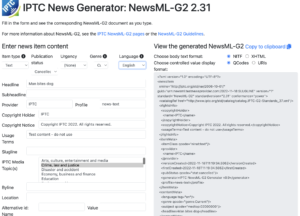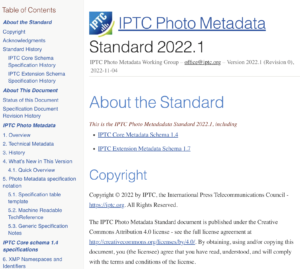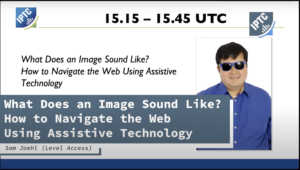Categories
Archives
The IPTC’s flagship news exchange standard, NewsML-G2, is now updated to version 2.31. The change was approved at the IPTC Standards Committee Meeting at the IPTC Autumn Meeting 2022.

The full NewsML-G2 XML Schema, NewsML-G2 Guidelines document and NewsML-G2 specification document have all now been updated.
The only change (Change Request CR00215) is that we now allow the hasInstrument element on any concept or assert. Previously we required hasInstrument to be declared on organisations only, but we realised that not every financial instrument related to an organisation: for example an exchange-traded fund, or the instrument for a commodity, do not directly relate to a specific company.
Interestingly, hasInstrument elements in <assert>s did appear to work in previous versions, but that is because of NewsML-G2’s use of the xs:any construct which allows asserts to be augmented with arbitrary elements. No validation took place on elements which were added in this way.
Examples
Example 1: hasInstrument as a child of concept
<concept> <conceptId qcode="P:18040196349" /> <type qcode="cptType:97"/> <name>Invesco Capital Appreciation Fund;R6</name> <hasInstrument symbol="OPTFX.O" type="symType:RIC" symbolsrc="symSrc:RFT"/> <hasInstrument symbol="US00141G7328" symbolsrc="symSrc:ISO" type="symType:ISIN"/> </concept>
Example 2: hasInstrument as a child of assert
<assert qcode="P:18040196349"> <name>Invesco Capital Appreciation Fund;R6</name> <type qcode="cptType:97"/> <hasInstrument symbol="OPTFX.O" type="symType:RIC" symbolsrc="symSrc:RFT"/> <hasInstrument symbol="US00141G7328" symbolsrc="symSrc:ISO" type="symType:ISIN"/> </assert>
Example 3: hasInstrument within assert/organisationDetails
This usage still works, but is now deprecated.
<assert qcode="P:18040196349"> <name>Invesco Capital Appreciation Fund;R6</name> <type qcode="cptType:97"/> <organisationDetails> <hasInstrument symbol="OPTFX.O" type="symType:RIC" symbolsrc="symSrc:RFT"/> <hasInstrument symbol="US00141G7328" symbolsrc="symSrc:ISO" type="symType:ISIN"/> <rtr:anyOtherElement> Other elements in other namespaces allowed here due to xs:any other </rtr:anyOtherElement> </organisationDetails> </assert>
- The top-level folder of the NewsML-G2 v2.31 release is http://iptc.org/std/NewsML-G2/2.31/.
- The NewsML-G2 Implementation Guidelines document, updated to cover version 2.31 is available at https://www.iptc.org/std/NewsML-G2/guidelines
- The latest NewsML-G2 Specification document is available at https://www.iptc.org/std/NewsML-G2/specification/
- The XML Schema for NewsML-G2 v2.31 is at http://iptc.org/std/NewsML-G2/2.31/specification/NewsML-G2_2.31-spec-All-Power.xsd
XML Schema documentation of version 2.31 version is available on GitHub and at http://iptc.org/std/NewsML-G2/2.31/specification/XML-Schema-Doc-Power/.
NewsML-G2 Generator updated
The NewsML-G2 Generator has been updated to use version 2.31. There are no substantive changes but the version number of generated files has been updated to 2.31.
Thanks to Dave Compton of Refinitiv (an LSE Group Company) and the NewsML-G2 Working Group for their work on the update, and to Kelvin Holland on his work on the documentation.
To follow our work on GitHub, please see the IPTC NewsML-G2 GitHub repository.
The full NewsML-G2 change log showing the Change Requests included in each new version is available at the dev.iptc.org site.
We had a great Photo Metadata Conference last Thursday. Thanks to those who attended. For those who didn’t, or those who would like to go over some detail again, here we publish full recordings of all sessions.
First up, Brendan Quinn, IPTC Managing Director introduced the day and gave an overview of what was to come:
Next was a great panel on adoption of the accessibility properties added in the 2021.1 update to the IPTC Photo Metadata Standard. We are very happy to share that the fields are now supported in many popular photo creating and editing tools, with more to come:
Next was David Riecks and Michael Steidl, co-leads of the IPTC Photo Metadata Working Group, presenting the work done by the Working Group since the last Photo Metadata Conference:
Then came a session on real-world implementations of the C2PA specification for content authenticity, including presentations from Microsoft, CBC / Radio Canada, the BBC and Adobe / Content Authenticity Initiative:
The last session was a panel discussion on Metadata for AI Images, looking at questions around the ethics of using copyrighted content to train a machine learning engine to generate AI images, and how the IPTC Photo Metadata Standard could be extended to support metadata appropriate for AI-generated images:
We had a great session and a packed conference! We look forward to seeing everyone again at next year’s event.
 Today, the IPTC announces the release of the IPTC Photo Metadata Standard, version 2022.1.
Today, the IPTC announces the release of the IPTC Photo Metadata Standard, version 2022.1.
The update has some changes to align the IPTC Photo Metadata Standard more closely which IPTC Video Metadata Hub, which helps with the integration into the C2PA specification as announced earlier this week.
The changes will be presented today (Thursday 10 November) at the IPTC Photo Metadata Conference, alongside sessions on AI and images, C2PA, and accessibility. You can still register for today’s Photo Metadata Conference, for free, at the IPTC Photo Metadata Conference 2022 event page. Video recordings from the event will be posted in the coming weeks.
The changes in detail
The IPTC Core schema has been updated to version 1.4, including the following changes:
-
Name of property Source changed to Source (Supply Chain)
-
Property Subject Code was set to legacy state
The IPTC Extension schema has been updated to version
-
New property Contributor (matching the equivalent property in IPTC Video Metadata Hub)
-
The property structure for Product has been extended with a new property Identifier
The specification document has also been updated with some edits and additions to Help Texts and User Notes.
Technical Reference update
The IPTC Photo Metadata TechReference has also been updated to include the changes in version 2022.1. This can be used by software makers to easily include the changes in the new version.
For more information on how to use the Technical Reference, please consult the IPTC Photo Metadata Technical Reference documentation.
Questions? Comments?
For any questions or comments on this update or on the IPTC Photo Metadata Standard in general, please post to the public IPTC Photo Metadata forum at iptc-photometadata@groups.io.

We are happy to announce that IPTC’s work with C2PA, the Coalition for Content Provenance and Authority, continues to bear fruit. The latest development is that C2PA assertions can now include properties from both the IPTC Photo Metadata Standard and our video metadata standard, IPTC Video Metadata Hub.
Version 1.2 of the C2PA Specification describes how metadata from either the photo or video standard can be added, using the XMP tag for each field in the JSON-LD markup for the assertion.
For IPTC Photo Metadata properties, the XMP tag name to be used is shown in the “XMP specs” row in the table describing each property in the Photo Metadata Standard specification. For Video Metadata Hub, the XMP tag can be found in the Video Metadata Hub properties table under the “XMP property” column.
We also show in the example assertion how the new accessibility properties can be added using the Alt Text (Accessibility) field which is available in Photo Metadata Standard and will soon be available in a new version of Video Metadata Hub.

We are proud to announce that Camera Bits, Mobius Labs, Microsoft, Smithsonian, CBC and many others will be presenting at the IPTC Photo Metadata Conference next week, Thursday 10th November. With a theme of Photo Metadata in the Real World, the event is free for anyone to attend. Register here for the Zoom webinar to receive details before the event.
The event will run from 1500 UTC to 1800 UTC. The full agenda with timings is published on the event page.
We will start off with a short presentation on recent updates to the IPTC Photo Metadata Standard from David Riecks and Michael Steidl, co-leads of the IPTC Photo Metadata Working Group. This will include the new properties approved at the recent IPTC Autumn Meeting.
A session on Adoption of IPTC Accessibility properties will include speakers from Smithsonian, Camera Bits (makers of the photographers tool Photo Mechanic), Picvario presenting their progress implementing IPTC’s accessibility properties, announced at last year’s Photo Metadata Conference.
The next session will be Software Supporting the IPTC Photo Metadata Standard, where Michael Steidl and David Riecks, co-leads of the IPTC Photo Metadata Working Group, present their work on IPTC’s database of software supporting the Photo Metadata Standard, and the IPTC Interoperability tool, showing compatibility between tools for individual properties.
Use of C2PA in real-world workflows is the topic of the next session, demonstrating progress made in implementing C2PA technology to make images and video tamper-evident and to establish a provenance trail for creative works. Speakers include Nigel Earnshaw and Charlie Halford from the BBC, David Beaulieu and Jonathan Dupras from CBC/Radio Canada, Jay Li from Microsoft, and a speaker yet to be confirmed from the Content Authenticity Initiative.
The next session should be very exciting: Metadata for AI images will be the topic, featuring an introduction to synthetic media and “generative AI” images, including copyright and ownership issues behind the images used to train the machine learning models involved, from Brendan Quinn and Mark Milstein.
Then we have a panel session: How should IPTC support AI and generative models in the future? Questions to be covered include whether we should identify which tool, text prompt and/or model was used to create a generative image? Should we include a flag that indicates content was created using a “green”, copyright-cleared set of training images? And perhaps other questions too – please come along to ask your own questions! Speakers include Dmitry Shironosov, Everypixel / Dowel.ai / Synthetics.media, Martin Roberts from Mobius Labs and Sylvie Fodor from CEPIC. The session will be moderated by Mark Milstein from vAIsual.
Last year we had over 200 registrants and very lively discussions. We look forward to even more exciting presentations and discussions this time around! See you there. (Please don’t forget to register!)
Categories
Archives
- December 2025
- November 2025
- October 2025
- September 2025
- August 2025
- July 2025
- June 2025
- May 2025
- April 2025
- March 2025
- February 2025
- January 2025
- December 2024
- November 2024
- October 2024
- September 2024
- August 2024
- July 2024
- June 2024
- May 2024
- April 2024
- March 2024
- February 2024
- December 2023
- November 2023
- October 2023
- September 2023
- August 2023
- July 2023
- June 2023
- May 2023
- March 2023
- February 2023
- January 2023
- December 2022
- November 2022
- October 2022
- September 2022
- August 2022
- July 2022
- June 2022
- May 2022
- April 2022
- March 2022
- February 2022
- January 2022
- December 2021
- November 2021
- October 2021
- September 2021
- August 2021
- July 2021
- June 2021
- May 2021
- April 2021
- February 2021
- December 2020
- November 2020
- October 2020
- September 2020
- August 2020
- July 2020
- June 2020
- May 2020
- April 2020
- March 2020
- February 2020
- December 2019
- November 2019
- October 2019
- September 2019
- July 2019
- June 2019
- May 2019
- April 2019
- February 2019
- November 2018
- October 2018
- September 2018
- August 2018
- July 2018
- June 2018
- May 2018
- April 2018
- March 2018
- January 2018
- November 2017
- October 2017
- September 2017
- August 2017
- June 2017
- May 2017
- April 2017
- December 2016
- November 2016
- October 2016
- September 2016
- August 2016
- July 2016
- June 2016
- May 2016
- April 2016
- February 2016
- January 2016
- December 2015
- November 2015
- October 2015
- September 2015
- June 2015
- April 2015
- March 2015
- February 2015
- November 2014